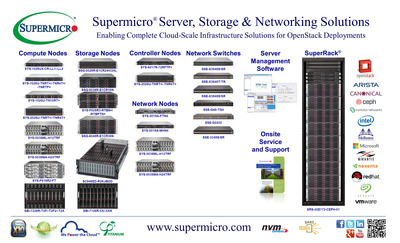|

Supermicro® Ultra Series, TwinPro(2)™, FatTwin™ SuperServers, SuperBlade®, SuperStorage, and 10/40GbE SDN Switches Enable Rapid Deployment of OpenStack Solutions
VANCOUVER, Canada, May 18, 2015 /PRNewswire/ -- Super Micro Computer, Inc. (NASDAQ: SMCI), a global leader in high-performance, high-efficiency server, storage technology and green computing collaborates with industry leading OpenStack partners to exhibit complete compute, storage and network/controller nodes at the OpenStack Summit this week in Vancouver, Canada. The Supermicro advantage encompasses open standards-based architecture, first-to-market advanced technologies, integrated server management software, global onsite services and support and an expanding ecosystem of best-in-class open source software partners.
 "Supermicro drives next generation open source Infrastructure as a Service into enterprise, data center, and cloud environments through our extensive range of server, storage, networking and management solutions," said Charles Liang, President and CEO of Supermicro. "Our latest Ultra, TwinPro, FatTwin, SuperBlade, SuperStorage and top-of-rack SDN switch solutions provide the best performance, flexibility configurability and reliability required for the dynamic, highly scalable environments. With an expanding ecosystem of deployment partners and best-in-class software solutions, we are delivering total rack solutions for any scale application."
OpenStack Infrastructure Solutions
Compute Nodes – 1U/2U/2U Ultra/2U Hyper-Speed/2U EX DP 32 DIMMs/3U MicroCloud/4U FatTwin™/7U SuperBlade® supporting quad Intel® Xeon® E7-8800/4800/2800 v2, dual Intel® Xeon® E5-2600 v3 or E3-1200 v3 CPUs, up to 24x DDR4 DIMMs up to 1.5TB, SAS3 12Gb/s, NVMe, 10GBase-T, 10G SFP+, 40G and InfiniBand Titanium Level, High-Efficiency (96%) Digital Power Supplies (SYS-1028UX-CR-LL1/-LL2, SYS-6018U-TRT+/-TRTP+/-TR4+/-TR4T+, SYS-1028U-TNRT+/-TNR4T+/-TNRTP+, SYS-1028U-TN10RT+, SYS-2028U-TRTP+, SYS-2028U-TNRT+/-TNR4T+, SYS-2028UT-BTNRT/-BC1NRT SYS-5038ML-H12TRF, SYS-5038MA-H24TRF, SYS-F618R2-FT, SBI-7228R-T2F/-T2F2/-T2X, SBI-7128RG-X/-F/-F2, SBI-7127RG/3, SBI-7126TG, SBI-7428R-T3/-T3N, SBI-7147R-S4F/-S4X)
Storage Nodes – 2U/4U 4-Node FatTwin™/4U 90x JBOD/7U SuperBlade® supporting SAS3 12Gb/s, NVMe, up to 8x 3.5" hot-swap HDD per U (4U FatTwin), 90x 3.5" to-load hot-swap HDDs in 4U (4U JBOD), systems support 16/24/36/72/90 drive bays (SSG-2028R-E1CR24H/24L, SSG-6038R-E1CR16N, SYS-F628R3-RTBN+/-RTBPTN+, SSG-6048R-E1CR36N, SC946ED-R2KJBOD, SBI-7128R-C6/-C6N)
Controller Nodes – 1U/2U SuperServers supporting dual Intel® Xeon® E5-2600 v3 CPUs (up to 160W TDP) up to 24x DDR4 DIMMs up to 1.5TB, SAS3 12Gb/s, NVMe, 10GBase-T, 10G SFP+, 40G and InfiniBand Titanium Level, High-Efficiency (96%) Digital Power Supplies (SYS-6017R-72RFTP+, SYS-2028U-TNRT+/-TNR4T+)
Network Nodes – 1U Short-Depth/3U MicroCloud supporting Intel® Atom™ C2758 SoC (20W, 8-core), Intel® Xeon) E5-2600 v3 or E3-1200 v3 CPUs (SYS-5018A-FTN4, SYS-5018A-MHN4, SYS-5038ML-H12TRF, SYS-5038MA-H24TRF)
Network Switches – 1U Top-of-Rack Switches in front or reverse airflow configurations supporting up to 48x 10GbE ports plus 6x 40GbE ports (SSE-X3648S/SR SDN enabled, SSE-X3848T/TR, SSE-X3848S/SR, SSE-G48-TG4, SSE-G2252, SSE-3348S/SR)
SuperRack® Solutions (SRK-42SE-02)
- 42U-320TB (SRS-42E112-CEPH-01) – Integrated Ceph Rack, 3x Mon, 8x 2U OSD, Networking & PDU
- 42U-1.08PB (SRS-42E136-CEPH-01) – Integrated Ceph Rack, 3x Mon, 9x 4U OSD, Networking & PDU
- 42U-2.16PB (SRS-42E172-CEPH-01) – Integrated Ceph Rack, 3x Mon, 9x 4U OSD, Networking & PDU
Server Management Software –Supermicro Server Manager (SSM) manages wide portfolio of Supermicro servers deployed across datacenters and enables remote health monitoring, power management and firmware upgrades with a single console. SSM through automation capabilities such as REST API and CLI accelerates deployment and maintenance of servers from independent nodes to Hyperscale clusters. SSM is also packaged with Supermicro Power Manager (SPM) that can manage power on heterogeneous server vendor products and Supermicro Update Manager (SUM) that provides strong CLI interfaces for firmware upgrades.
Onsite Service and Support – Global Program Provides Rapid Hardware Maintenance Response for Supermicro Customers. Features 24 x 7 x 4 or next Business Day hardware maintenance response to Enterprise Customers with complete Supermicro SuperServer solutions. SOWs provide access to Service & Support Integration and maintenance resource augmentation.
Supermicro end-to-end hyper-converged solutions will be on exhibit at OpenStack Summit 2015 in Vancouver, Canada May 18th through the 22nd at the Vancouver Convention Centre. For more information on Supermicro's complete range of high performance, high-efficiency Server, Storage and Networking solutions, visit www.supermicro.com.
Follow Supermicro on Facebook and Twitter to receive their latest news and announcements.
About Super Micro Computer, Inc.
Supermicro® (NASDAQ: SMCI), the leading innovator in high-performance, high-efficiency server technology is a premier provider of advanced server Building Block Solutions® for Data Center, Cloud Computing, Enterprise IT, Hadoop/Big Data, HPC and Embedded Systems worldwide. Supermicro is committed to protecting the environment through its "We Keep IT Green®" initiative and provides customers with the most energy-efficient, environmentally-friendly solutions available on the market.
Supermicro, Building Block Solutions and We Keep IT Green are trademarks and/or registered trademarks of Super Micro Computer, Inc.
The OpenStack® Word Mark and OpenStack Logo are either registered trademarks / service marks or trademarks / service marks of the OpenStack Foundation, in the United States and other countries and are used with the OpenStack Foundation's permission. We are not affiliated with, endorsed or sponsored by the OpenStack Foundation or the OpenStack community
All other brands, names and trademarks are the property of their respective owners.
SMCI-F
Photo - http://photos.prnewswire.com/prnh/20150516/216437
To view the original version on PR Newswire, visit:http://www.prnewswire.com/news-releases/supermicro-ultra-series-twinpro2-fattwin-superservers-superblade-superstorage-and-1040gbe-sdn-switches-enable-rapid-deployment-of-openstack-solutions-300084457.html
SOURCE Super Micro Computer, Inc.
[ Back To Transforming Network Infrastructure's Homepage ]
|
